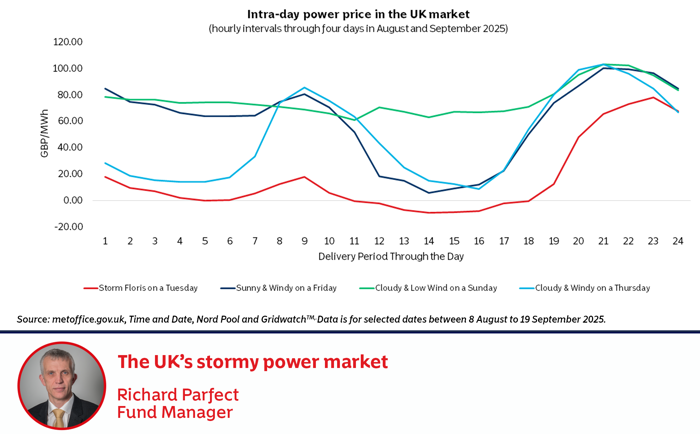
What this chart shows
This shows the intra-day power price in the UK market at hourly intervals through four days in August and September.
Why this is important
Critics of renewable energy say that it is expensive and unreliable. There is justification for the latter assertion when it is sub-scale, uncoordinated and reliant on the vagaries of the British weather; however scale and coordination are not unsurmountable hurdles, indeed that is a core area of required investment focus. However, when it comes to the assertion of it being expensive (at least relative to the marginal supply source of gas), the data shows the contrary.
The four lines show how the power price varies through four different days which vary between one another in terms of day of the week and weather type. We can see that on a day where there is very little wind or sun the power price is relatively stable but high. Notably that is despite it being on a Sunday where you would typically see less power demand. Conversely a day where there is ample wind (Storm Floris) can generate negative power prices. Therefore, on cloudy, calm days, aside from the UK’s baseload nuclear generation, the electricity grid is having to be predominantly powered by gas, the price of which has soared in recent years, especially due to the Russia/Ukraine war.
Other days demonstrate a clear diurnal variation of power price with a bias towards lower prices during the day when solar and wind are more likely to be able to generate electricity (wind speeds are generally higher by day than by night).
The available ‘feedstock’ for renewables (the sun and wind) is free, but the capital required for construction is high (particularly for offshore wind, less so for ground mounted solar). Nevertheless, once installed and operational the running costs are relatively low. That is before we factor in the hidden financial costs of non-renewable sources of energy.
The UK benefits from other potential sources of energy such as a tidal range that is one of the largest in the world and which could provide semi-base load generation. The offshore wind industry has had a very difficult year, not least due to President Trump’s personal animosity towards it which is reflective of his objection to them ‘blighting’ the view from his Scottish golf courses. However, the UK’s significant investment in this space over the last 10 years has softened the blow that would otherwise have occurred if we were more reliant on gas.
There is a huge employment and economic growth opportunity to grasp as various solutions need and can be found to help rectify the intermittency, intra-day demand imbalances and capacity constraints that create these higher price and associated volatility.
Global markets balanced political and economic uncertainty: US shutdown and UK weakness contrasted with EU tech resilience, China stimulus, and tentative Middle East peace, prompting cautious optimism.

-
The US federal government entered a partial shutdown as of 1 October, delaying or suspending many non-essential operations and threatening delays in crucial data releases.
-
In advance of the shutdown, the Trump administration released plans for which agencies would cut back and notably floated the possibility of mass federal employee firings, intensifying political risk.
-
The US private sector (ADP) reported a surprising decline of 32,000 jobs in September, raising questions about the strength of the labour market.
-
Despite political volatility, equity markets held up: the S&P 500, Nasdaq and other indexes notched new highs, supported by expectations that the Fed would cut rates further this year.

-
Business activity in the UK slowed: the services PMI was revised lower to 50.8 in September, its weakest since April, and the composite index was marginally above the 50 growth/contraction threshold.
-
UK firms’ hiring intentions were among the weakest since 2020, as businesses grew cautious ahead of the 26 November autumn budget and amid inflation pressures.
-
Chancellor Rachel Reeves warned against uncontrolled spending, emphasising that market confidence could be lost immediately if fiscal discipline is not maintained.
-
The Bank of England’s Governor Andrew Bailey cautioned against deregulating banks or rolling back financial oversight, as the central bank monitors new risk areas.

-
European equities performed strongly, supported by sector rotation into pharmaceuticals and tech, as global risk sentiment improved.
-
The EU continued pushing for greater technological sovereignty (notably in AI infrastructure and supply chains) to reduce dependence on US and Chinese systems.
-
Trade and regulatory alignment with the UK saw incremental easing: for instance, limited exemptions were mooted under the EU’s carbon border adjustment (CBAM) to reduce abrupt cost shocks to UK firms.
-
EU regulators also continued scrutiny of financial and tech markets, including calls for strengthened rules on stablecoins and proposals for tighter oversight of bank capital frameworks.

-
Hamas signalled partial acceptance of Donald Trump’s 20-point Middle East peace proposal, agreeing in principle to key terms such as ending the war, Israel’s withdrawal, and the release of Israeli hostages and Palestinian captives. However, the group deferred several contentious points, including whether it would disarm, to further talks in Egypt, leaving major questions unresolved.
-
Despite China being closed for Golden week from the 1-7 October they announced a new package of ¥500 billion (~US$70 billion) in targeted financing tools to support investment and stabilise growth amid soft data.
-
Growth in the “new economy” sectors (AI, semiconductors, advanced manufacturing) continued to outpace broader industrial indicators, signalling the structural tilt in China’s growth strategy.
-
Japan’s markets were on edge in advance of the LDP leadership vote, with concerns about how the next premier’s economics and foreign policy would shift market direction.
